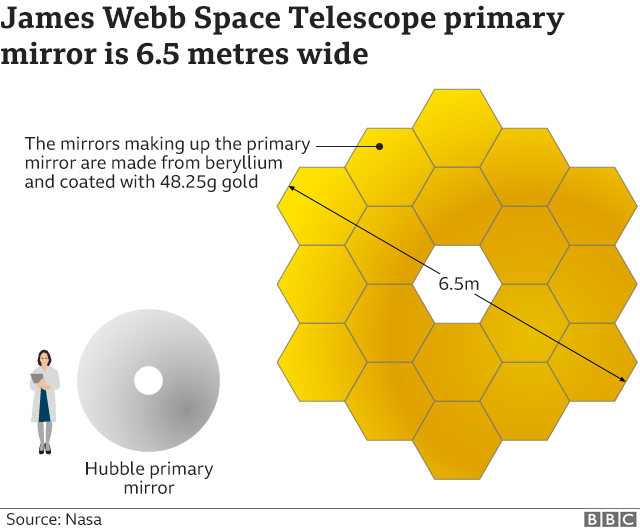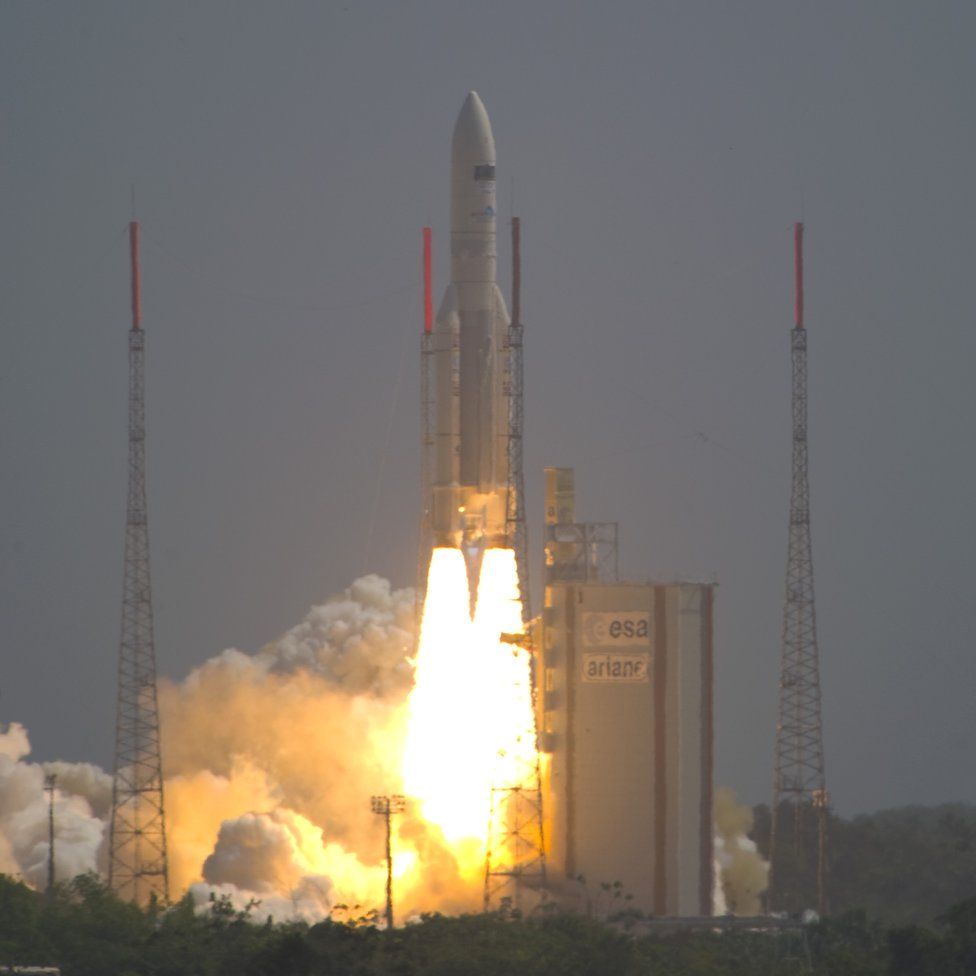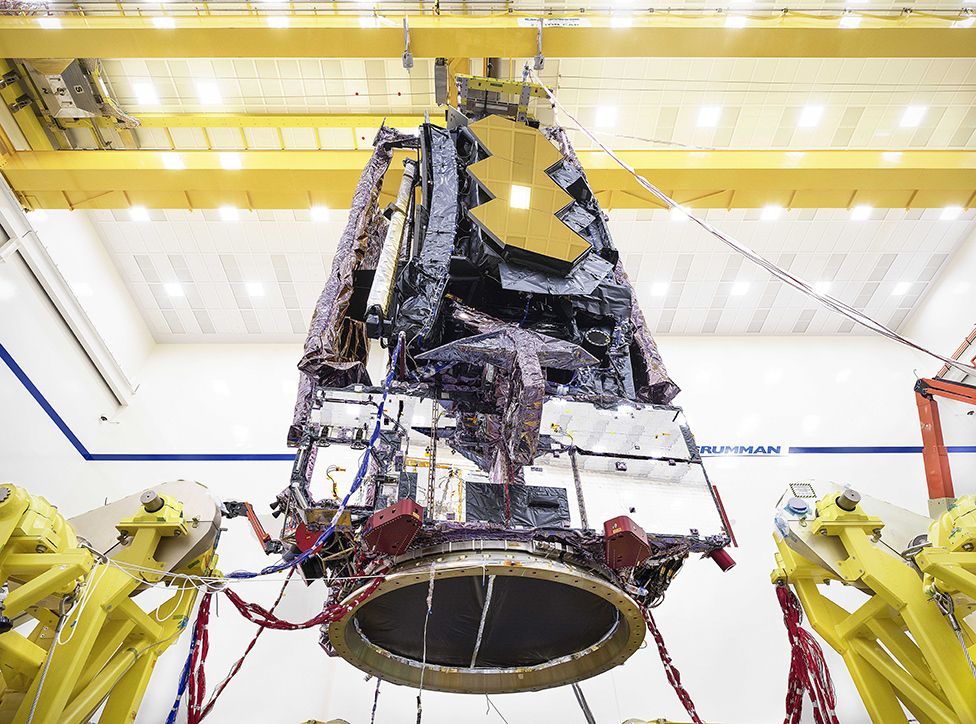8.09.2021
Targeted launch date for Webb: 18 December 2021

ESA, NASA and Arianespace have jointly defined 18 December 2021 as the target launch date for Ariane 5 flight VA256. This third Ariane 5 launch of 2021 will fly the James Webb Space Telescope to space from Europe's Spaceport in French Guiana.
Important milestones of the launch programme for Webb have already been passed or are approaching, such as the final mission analysis review for its launch, the shipment of the Ariane 5 launch vehicle elements from continental Europe to French Guiana, and the scheduled shipment of Webb to French Guiana by the end of September 2021.
Webb is an international partnership between NASA, ESA, and the Canadian Space Agency (CSA). As part of the international collaboration agreement, ESA is providing the telescope’s launch service using the Ariane 5 launch vehicle. Working with partners, ESA was responsible for the development and qualification of Ariane 5 adaptations for the Webb mission and for the procurement of the launch service. Besides that, ESA is contributing the NIRSpec instrument and a 50% share of the MIRI instrument, as well as personnel to support mission operations.
“ESA is proud that Webb will launch from Europe’s Spaceport on an Ariane 5 rocket specially adapted for this mission. We are on track, the spaceport is busy preparing for the arrival of this extraordinary payload, and the Ariane 5 elements for this launch are coming together. We are fully committed, with all Webb partners, to the success of this once-in-a-generation mission,” said Daniel Neuenschwander, ESA Director of Space Transportation.
“We now know the day that thousands of people have been working towards for many years, and that millions around the world are looking forward to. Webb and its Ariane 5 launch vehicle are ready, thanks to the excellent work across all mission partners. We are looking forward to seeing the final preparations for launch at Europe’s Spaceport,” said Günther Hasinger, ESA Director of Science.

Ariane 5 will deliver the telescope directly into a precision transfer orbit towards its destination, the second Lagrange point (L2). After separation from the Ariane 5, Webb will continue its four-week long journey to L2 alone. L2 is four times farther away than the Moon, 1.5 million km from Earth in the direction away from the Sun.
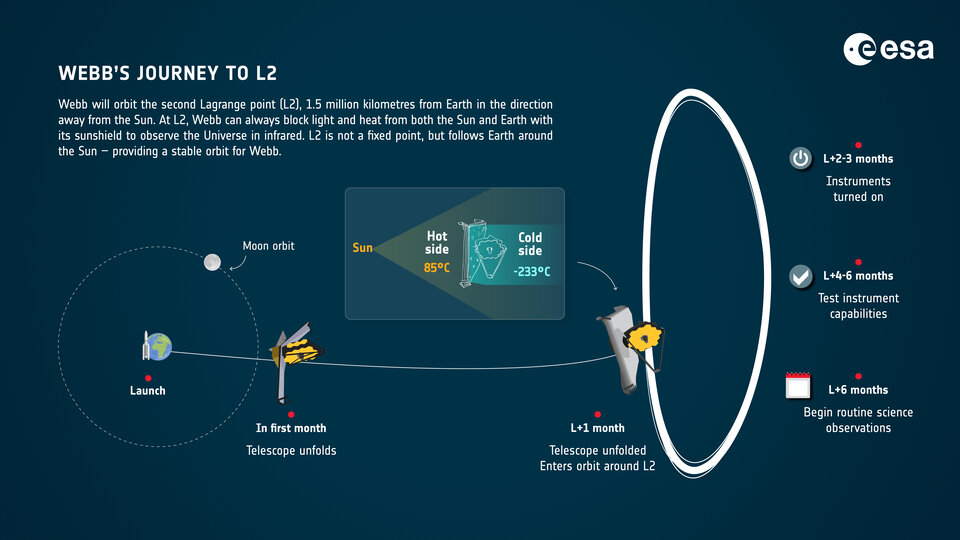
Webb will observe the Universe at wavelengths longer than visible light, namely in the near-infrared and mid-infrared. To do so, it carries a suite of state-of-the-art cameras, spectrographs and coronagraphs. Webb will cover longer wavelengths of light than the Hubble Space telescope and has a 100 times improved sensitivity, which opens up a new window to the Universe. The longer wavelengths enable Webb to uncover hidden parts of our Solar System, peer inside dust clouds where stars and planetary systems are forming, reveal the composition of exoplanets' atmospheres in more detail, and look farther back in time to see the first galaxies that formed in the early Universe.
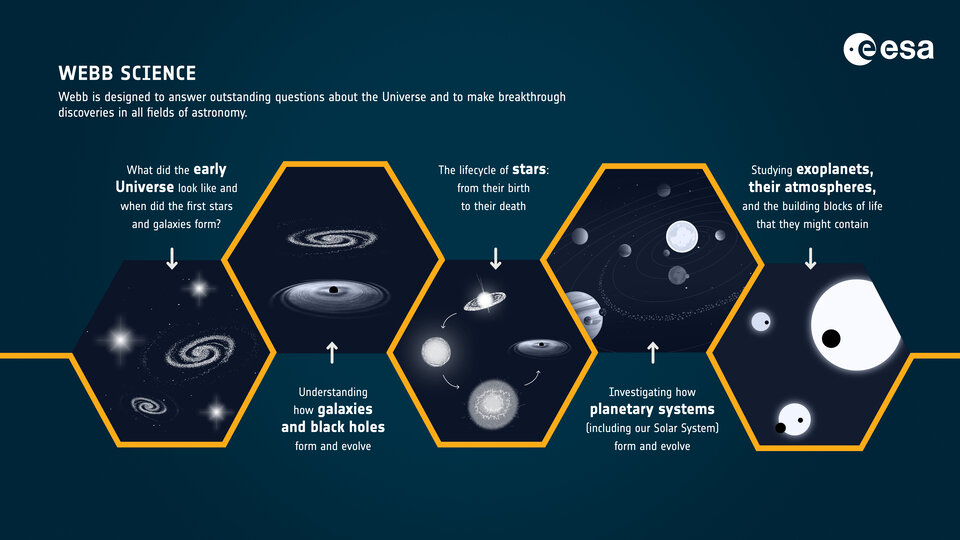
With its unique abilities, Webb is a key mission among ESA’s fleet of space science missions that unlock the secrets of the Universe. Its discoveries will complement those of ESA’s current and upcoming exoplanet missions: Cheops, Plato, and Ariel. Webb will also follow up on detections from Euclid, ESA’s upcoming spacecraft to understand the fabric of our cosmos. Furthermore, Webb’s discoveries will help set the stage for ESA’s future X-ray mission Athena and gravitational wave detector LISA.
About Ariane 5
Ariane 5 is an ESA programme. The launch vehicle is manufactured by ArianeGroup. Arianespace is responsible for operating Ariane 5 from Europe’s Spaceport in French Guiana on the northeastern coast of South America. The French space agency CNES maintains and develops the launch range infrastructures and also provides essential support for launch vehicle and satellite preparation. ESA owns the launch infrastructure and is the launch vehicle design authority.
Quelle: ESA
----
Update: 24.09.2021
.
NASA Invites Media to Webb Telescope Prelaunch Events in French Guiana

NASA invites members of the media to register their interest in attending events in French Guiana ahead of the launch of the James Webb Space Telescope, a mission led by NASA in partnership with the European and Canadian space agencies. Events will take place Nov. 4-6 at the launch site – Europe's Spaceport in Kourou, French Guiana, on the northeastern coast of South America – following the observatory’s arrival and the start of prelaunch preparations.
Participating media will have the opportunity to view the Webb Telescope in its stow configuration from a visitor gallery outside the clean room. Access to the clean room will not be available. Participants also will tour the launch facilities and Ariane 5 control center, view the Ariane 5 VA256 rocket, and have an opportunity to interview members of the mission teams. Refer to itinerary of events for full details.
Media interested in attending these prelaunch events in French Guiana must provide their name and affiliation by 5 p.m. EDT Monday, Sept. 27, to Laura Betz at: laura.e.betz@nasa.gov and Alise Fisher at: alise.m.fisher@nasa.gov. Due to COVID-19 restrictions and space limitations, NASA and its mission partners may be unable to accommodate all requests for attendance.
Interested media should note the following travel information:
- Proof of vaccination for yellow fever is required for all travelers arriving in French Guiana.
- Proof of a negative COVID-19 test is required for travelers to French Guiana. Individuals who are not vaccinated against COVID-19 may also be required to quarantine for seven days in French Guiana upon arrival.
- COVID-19 levels are currently high in French Guiana. Local safety restrictions may include a daily curfew from 7 p.m. to 5 a.m. and restaurant closures.
- A limited number of hotel accommodations will be available in Cayenne, French Guiana, the nearest large city to the launch site, about 30 miles (48 kilometers) southeast of Kourou.
NASA is documenting Webb’s journey to the launch site, arrival in Kourou, and payload processing. Photo and video assets will be available to all media.
NASA’s Webb Space Telescope, which is targeted to launch Dec. 18, will serve as the premier deep space observatory for the next decade and explore every phase of cosmic history – from within our solar system to the most distant observable galaxies in the early universe, and everything in between. Webb will reveal new and unexpected discoveries, and help humanity understand the origins of the universe and our place in it.
Quelle: NASA
----
Update: 3.10.2021
.
NASA won’t rename James Webb telescope — and astronomers are angry
Quelle: BBC
+++
NASA’s Webb Space Telescope Arrives in French Guiana After Sea Voyage

Editor's note: This release was updated Oct. 12 to correct the distance traveled to Kourou.
NASA’s James Webb Space Telescope successfully arrived in French Guiana Tuesday, after a 16-day journey at sea. The 5,800-mile voyage took Webb from California through the Panama Canal to Port de Pariacabo on the Kourou River in French Guiana, on the northeastern coast of South America.
The world’s largest and most complex space science observatory will now be driven to its launch site, Europe’s Spaceport in Kourou, where it will begin two months of operational preparations before its launch on an Ariane 5 rocket, scheduled for Dec. 18.
Once operational, Webb will reveal insights about all phases of cosmic history – back to just after the big bang – and will help search for signs of potential habitability among the thousands of exoplanets scientists have discovered in recent years. The mission is an international collaboration led by NASA, in partnership with the European and Canadian space agencies.
“The James Webb Space Telescope is a colossal achievement, built to transform our view of the universe and deliver amazing science,” said NASA Administrator Bill Nelson. “Webb will look back over 13 billion years to the light created just after the big bang, with the power to show humanity the farthest reaches of space that we have ever seen. We are now very close to unlocking mysteries of the cosmos, thanks to the skills and expertise of our phenomenal team.”
After completing testing in August at Northrop Grumman's Space Park in Redondo Beach, California, the Webb team spent nearly a month folding, stowing, and preparing the massive observatory for shipment to South America. Webb was shipped in a custom-built, environmentally controlled container.
Late in the evening of Friday, Sept. 24, Webb traveled with a police escort 26 miles through the streets of Los Angeles, from Northrop Grumman's facility in Redondo Beach to Naval Weapons Station Seal Beach. There, it was loaded onto the MN Colibri, a French-flagged cargo ship that has previously transported satellites and spaceflight hardware to Kourou. The MN Colibri departed Seal Beach Sunday, Sept. 26 and entered the Panama Canal Tuesday, Oct. 5 on its way to Kourou.
The ocean journey represented the final leg of Webb's long, earthbound travels over the years. The telescope was assembled at NASA's Goddard Space Flight Center in Greenbelt, Maryland, starting in 2013. In 2017, it was shipped to NASA's Johnson Space Center in Houston for cryogenic testing at the historic “Chamber A” test facility, famous for its use during the Apollo missions. In 2018, Webb shipped to Space Park in California, where for three years it underwent rigorous testing to ensure its readiness for operations in the environment of space.
“A talented team across America, Canada, and Europe worked together to build this highly complex observatory. It’s an incredible challenge – and very much worthwhile. We are going to see things in the universe beyond what we can even imagine today,” said Thomas Zurbuchen, associate administrator for NASA’s Science Mission Directorate in Washington. “Now that Webb has arrived in Kourou, we’re getting it ready for launch in December – and then we will watch in suspense over the next few weeks and months as we launch and ready the largest space telescope ever built.”
After Webb is removed from its shipping container, engineers will run final checks on the observatory’s condition. Webb will then be configured for flight, which includes loading the spacecraft with propellants, before Webb is mounted on top of the rocket and enclosed in the fairing for launch.
"Webb’s arrival at the launch site is a momentous occasion,” said Gregory Robinson, Webb’s program director at NASA Headquarters. “We are very excited to finally send the world’s next great observatory into deep space. Webb has crossed the country and traveled by sea. Now it will take its ultimate journey by rocket one million miles from Earth, to capture stunning images of the first galaxies in the early universe that are certain to transform our understanding of our place in the cosmos.”
Quelle: NASA
----
Update: 21.10.2021
.
$10bn James Webb Space Telescope unpacked in Kourou
Engineers have unboxed the James Webb Space Telescope in French Guiana and will now prepare it for launch.
The $10bn successor to the Hubble observatory arrived at Europe's Kourou spaceport five days ago after being shipped from the US.

It's now been relieved of its transport container and raised into the vertical to allow preflight checks to begin.
JWST is one of the grand scientific projects of the 21st Century and will ride to orbit on 18 December.

An Ariane-5 rocket will throw the telescope out to an observing position about 1.5 million km from Earth.
From there, it will look deeper into the cosmos - and thus further back in time - than is possible with Hubble.
It will do this with a much bigger mirror (6.5m in diameter versus 2.4m) and instruments that are tuned to the infrared.
Scientists hope this set-up can detect the light from the very first population of stars in the Universe to switch on more than 13.5 billion years ago.
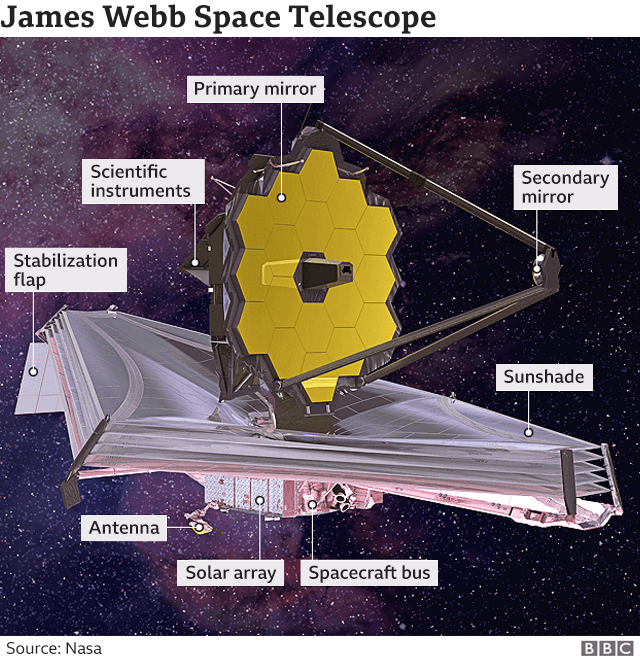
JWST is a joint venture between the US (Nasa), European (Esa) and Canadian space agencies (CSA).
It's taken more than three decades from the original conception to get to this point.
Final assembly and testing was completed in August at the Northrop Grumman factory in Redondo Beach, California, after which the telescope was made ready for a 16-day, 2,500km journey by sea to French Guiana, a trip that took the observatory through the Panama Canal.
Teams at Europe's spaceport will first inspect JWST to confirm no damage was picked up in transit. The telescope will then be fuelled and mated to the Ariane 5.
Recent weeks have seen cargo planes arrive in French Guiana with the tools and support equipment needed to work on Webb over the coming weeks.
A key milestone in the preparations comes this Friday when another Ariane-5 is due to launch two communications satellites from Kourou. This has to take place to free up the launch table on which Webb's rocket will be integrated.
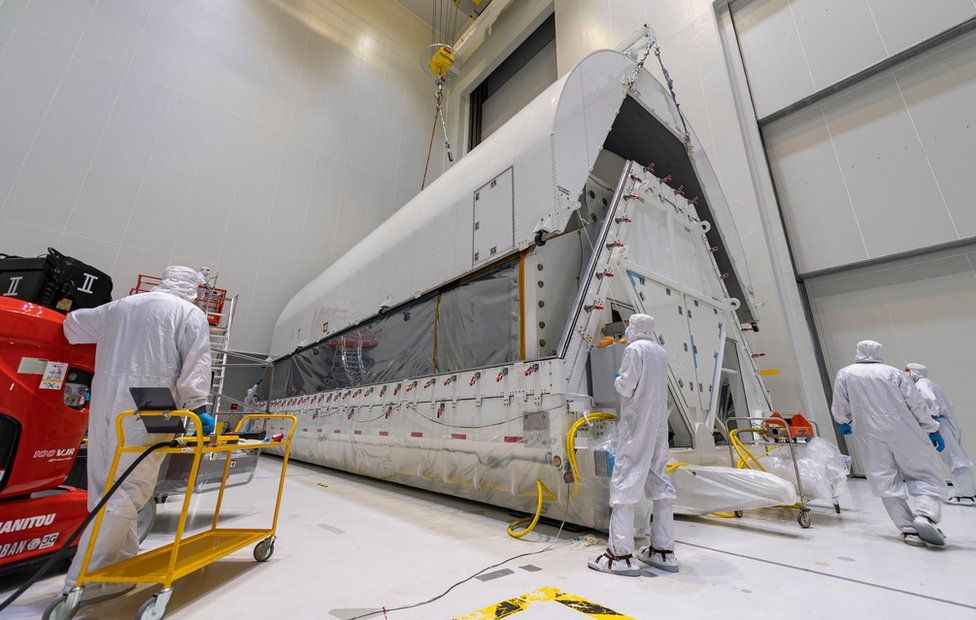 IMAGE SOURCE, ESA/CNES/ARIANESPACE/P.PIRON
IMAGE SOURCE, ESA/CNES/ARIANESPACE/P.PIRON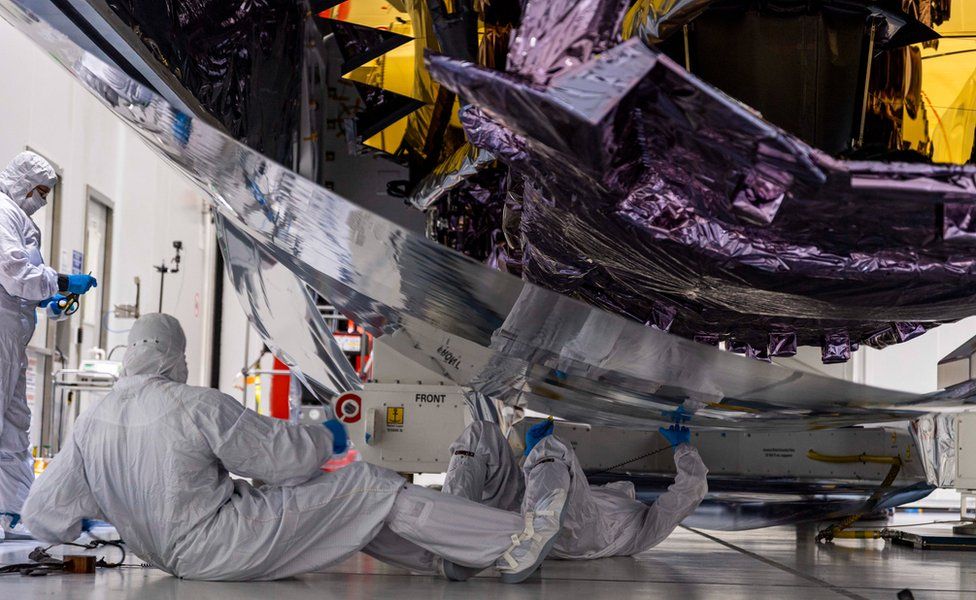 IMAGE SOURCE, ESA/CNES/ARIANESPACE/P.PIRON
IMAGE SOURCE, ESA/CNES/ARIANESPACE/P.PIRONQuelle: BBC
----
Update: 30.10.2021
.
JWST launch preparations on track

DUBAI, U.A.E. — The success of the most recent Ariane 5 launch has allowed preparations for the launch of NASA’s James Webb Space Telescope to move into the home stretch, officials said Oct. 27.
During a panel discussion at the 72nd International Astronautical Congress, representatives of NASA, the European Space Agency, Arianespace and other expressed confidence that the long-delayed giant space telescope will finally launch on Dec. 18.
That confidence is bolstered by the successful launch of the most recent Ariane 5 mission Oct. 23, placing into geostationary transfer orbit the SES-17 communications satellite for SES and the Syracuse 4A communications satellite for France’s military. The total payload mass of 10,264 kilograms was the heaviest for a geostationary orbit mission by any vehicle to date.
Stéphane Israël, chief executive of Arianespace, said on the panel that the final review of that launch was scheduled for Oct. 28. “It will be a very important milestone” allowing work to begin on the Ariane 5 launch of JWST, he said. The launch campaign for JWST will formally begin Nov. 6 for a Dec. 18 launch.
The spacecraft itself arrived in French Guiana Oct. 12, traveling by ship from Southern California. “The observatory is in the high bay in French Guiana,” beginning launch preparations, said Greg Robinson, JWST program director at NASA Headquarters. Fueling of the spacecraft will take place in about a month, after which it will be installed on the launch vehicle.
He said the team in French Guiana has had to deal with only minor issues associated with logistics, such as food and lodging, rather than technical issues with the spacecraft. Launch preparations have been running ahead of schedule, giving NASA some breathing room.
“We have a minimum of 11 days margin,” he said. “I have no concerns about margin. We’re in a really good state.” That margin will shrink once JWST is fueled and integrated with the Ariane 5, he added, but that is expected.
There’s also margin in launch vehicle preparations, Israël said. That includes accounting for two other launches at the spaceport ahead of JWST: a Vega launch of a cluster of French military smallsats in November and a Soyuz launch of two Galileo navigation satellites at the end of November. “We have margin, and we are very, very confident that we will be on time for the 18th of December.”
“We are in now the final, final mile heading towards this historical launch,” he said. “We feel the pressure, but it is a positive pressure for excellence, and we will deliver.”
Quelle: SN
----
Update: 10.11.2021
.
Ariane 5 fairing cleared for Webb launch after “perfect” performance on last flight

The payload fairing on the most recent Ariane 5 launch last month worked perfectly, according to the European Space Agency, helping clear concerns about the shroud before liftoff of the James Webb Space Telescope on the next Ariane 5 flight in December.
The nose cone structure, built by the Swiss company RUAG Space, is designed to protect sensitive satellites during their time on the launch pad before liftoff, and during the first few minutes of ascent through the atmosphere. Once in space, the rocket jettisons the no-longer-needed fairing in two pieces, like the halves of a clamshell.
On two Ariane 5 missions last year, the payload fairing separated from the launcher in a “less than fully nominal” manner, causing vibrations on the rocket’s satellite passengers above safety limits. The satellites were not damaged by the payload fairing separation anomalies, and the Ariane 5 successfully placed the payloads into their intended orbits.
But Arianespace, the Ariane 5’s commercial launch operator, paused launches to investigate the fairing problem. Arianespace introduced a change to the fairing for the two most recent Ariane 5 flights on July 30 and Oct. 23.
Those missions validated the change to the fairing, according to Daniel De Chambure, acting head of the Ariane 5 adaptation program for the European Space Agency.
“The last flight was absolutely perfect with respect to the fairing separation, both in terms of dynamics of the launcher and also in the kinematical separation effects,” de Chambure said Friday during a media tour of the Ariane 5 launch base in Kourou, French Guiana. “For everybody — Arianespace, NASA, and ESA — there is no issue any more with respect to this anomaly we faced last year.”
Peter Jensen, ESA’s former project manager for Webb and now a consultant on the program, said the payload fairings flown in July and October were fully instrumented. “So we have a full picture of what happened to the fairing.”
NASA, ESA, and Arianespace managers discussed the Ariane 5 fairing data and other mission details during a flight readiness review Oct. 28. The readiness review cleared the way for the start of the Ariane 5 launch campaign at the Guiana Space Center, a European-run spaceport on the northern coast of South America.
Teams at the spaceport raised the Ariane 5 rocket’s core stage onto a mobile launch platform Saturday inside the launcher integration building. Two powerful solid rocket boosters, already packed with their powder propellant, are set to be installed on each side of the core stage in the next few days.
Once the rocket’s upper stage and avionics bay are stacked, Arianespace will transfer the Ariane 5 to a nearby final assembly building, where the 35-foot-tall (10.66-meter) Webb observatory will be hoisted on top of the launcher. The final piece to be added will the payload fairing to surround Webb.
The Ariane 5 will roll to the launch pad Dec. 16 in preparation for liftoff at 7:20 a.m. EST (1220 GMT; 9:20 a.m. French Guiana time) on Dec. 18.
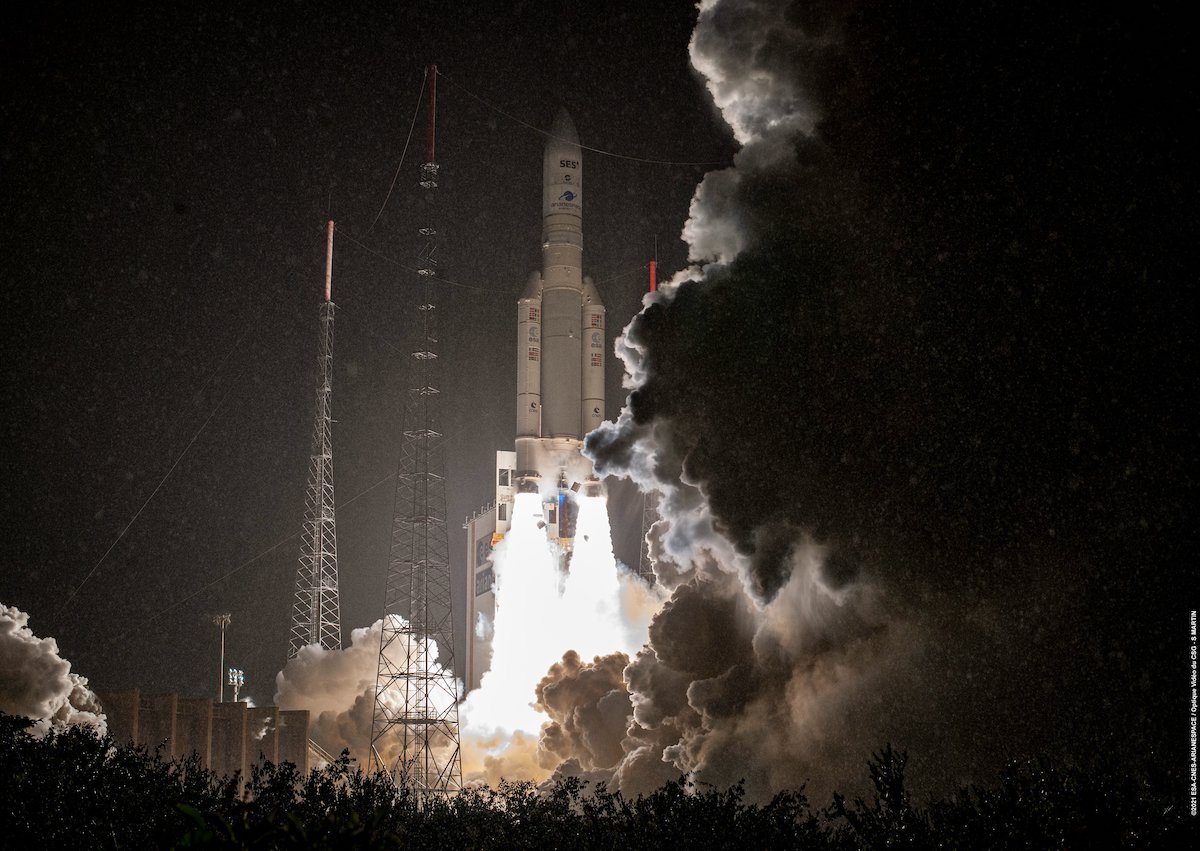
The James Webb Space Telescope folds up origami-style to fit under the Ariane 5 rocket’s payload shroud, then unfurl solar panels, antennas, a segmented mirror array, and a thermal sunshield the size of a tennis court after separating from the Ariane 5 on the way to an observing post nearly a million miles (1.5 million kilometers) from Earth.
Once in position, JWST’s telescope — the largest ever flown in space — and four science instruments will peer into the distant universe, studying the turbulent aftermath of the Big Bang, the formation of galaxies and the environments of planets around other stars.
ESA, Arianespace and RUAG also changed the design of vents on the Ariane 5’s payload shroud to address a concern that a depressurization event could damage the Webb observatory when the fairing jettisons after liftoff. Engineers were concerned residual air trapped in Webb’s folded sunshield membranes could cause them to suddenly bubble or expand at the time of fairing separation.
The vent modification will help sure there is no air caught between the sunshield membranes as the rocket climbs above the atmosphere.
The Ariane 5 is one of the most reliable launch vehicles in the world, with just one partial failure in its last 97 missio




